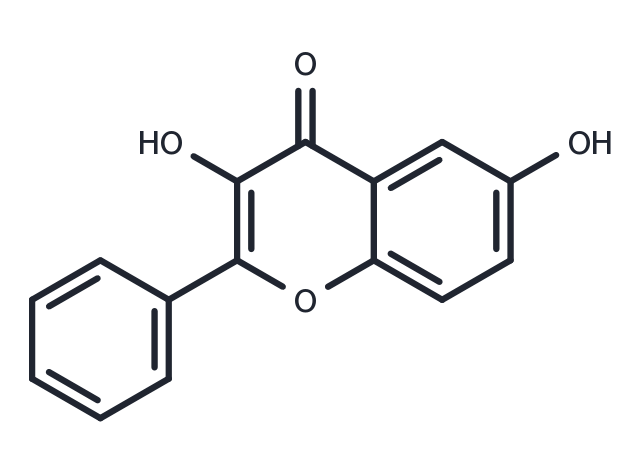Powder: -20°C for 3 years | In solvent: -80°C for 1 year
3,6-Dihydroxyflavone suppresses the epithelial-mesenchymal transition in breast cancer cells by inhibiting the Notch signaling pathway.

| パッケージサイズ | 在庫状況 | 単価(税別) | |||
|---|---|---|---|---|---|
| サンプルについてお問い合わせ | |||||
| 10 mg | 在庫あり | ¥ 15,500 | |||
| 100 mg | 在庫あり | ¥ 73,500 | |||
| 1 mL * 10 mM (in DMSO) | 在庫あり | ¥ 10,500 | |||
| 説明 | 3,6-Dihydroxyflavone suppresses the epithelial-mesenchymal transition in breast cancer cells by inhibiting the Notch signaling pathway. |
| In vitro | 3,6-Dihydroxyflavone(3,6-DHF) could effectively inhibit EMT in BC cells in vitro and in vivo.?3,6-DHF effectively inhibits the formation and proliferation of BCSCs, and consequently reduces the tumor-initiating capacity of tumor cells in NOD/SCID mice.?Optical in vivo imaging of cancer metastasis showed that 3,6-DHF administration suppresses the lung metastasis of BC cells in vivo.?Further studies indicated that 3,6-DHF down-regulates Notch1, NICD, Hes-1 and c-Myc, consequently decreasing the formation of the functional transcriptional unit of NICD-CSL-MAML, causing Notch signaling inactivation in BC cells.?Over-expression of Notch1 or inhibition of miR-34a significantly reduced the inhibitory effects of 3,6-DHF on EMT, CSCs, as well as cells migration and invasion in BC cells[1]. |
| 細胞研究 | Cells were cultured in six-well plates until they reached 100% confluence. A vertical or horizontal wound was gently created in monolayers using a 20 μl sterile pipette tip. The cells were then washed for 3 times with growth medium to remove the detached cells, and the medium was added with fresh medium treated with 3,6-DHF. Images were captured using an inverted microscope and camera at designed times to assess the inhibition of wound closure[1]. |
| 分子量 | 254.24 |
| 分子式 | C15H10O4 |
| CAS No. | 108238-41-1 |
Powder: -20°C for 3 years | In solvent: -80°C for 1 year
DMSO: 27.5 mg/mL (108.17 mM)
You can also refer to dose conversion for different animals. 詳細
bottom
Please see Inhibitor Handling Instructions for more frequently ask questions. Topics include: how to prepare stock solutions, how to store products, and cautions on cell-based assays & animal experiments, etc.
3,6-Dihydroxyflavone 108238-41-1 Others inhibit Inhibitor caspase cascade cell viability oxidative stress 3,6-DHF Apoptosis PARP lipid peroxidation 3,6 Dihydroxyflavone 3,6Dihydroxyflavone inhibitor
